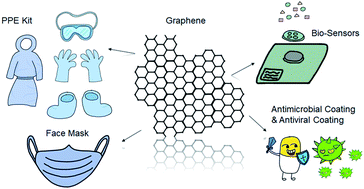A case study of SARS-CoV-2 transmission behavior in a severely air-polluted city (Delhi, India) and the potential usage of graphene based materials for filtering air-pollutants and controlling/monitoring the COVID-19 pandemic
Abstract
Globally, humanity is facing its most significant challenge in 100 years due to the novel coronavirus, SARS-CoV-2, which is responsible for COVID-19. Under the enormous pressure created by the pandemic, scientists are studying virus transmission mechanisms in order to develop effective mitigation strategies. However, no established methods have been developed to control the spread of this deadly virus. In addition, the ease in lockdown has escalated air pollution which may affect SARS-CoV-2 transmission through attachment to particulates. The present review summarizes the role of graphene nanomaterials, which show antimicrobial behavior and have antiviral efficacy, in reducing the spread of COVID-19. Graphene and its derivatives have excellent antimicrobial efficacy, providing both physical and chemical mechanisms of damage. Coupled with their lightness, optimal properties, and ease of functionalization, they are optimal nanomaterials for coating onto fabrics such as personal protection equipment, face masks and gloves to control the transmission of SARS-CoV-2 effectively. Biosensors using graphene can effectively detect the virus with high accuracy and sensitivity, providing rapid quantification. It is envisioned that the present work will boost the development of graphene-based highly sensitive, accurate and cost-effective diagnostic tools for efficiently monitoring and controlling the spread of COVID-19 and other air-borne viruses.

- This article is part of the themed collection: Environmental Science – coronavirus research


 Please wait while we load your content...
Please wait while we load your content...